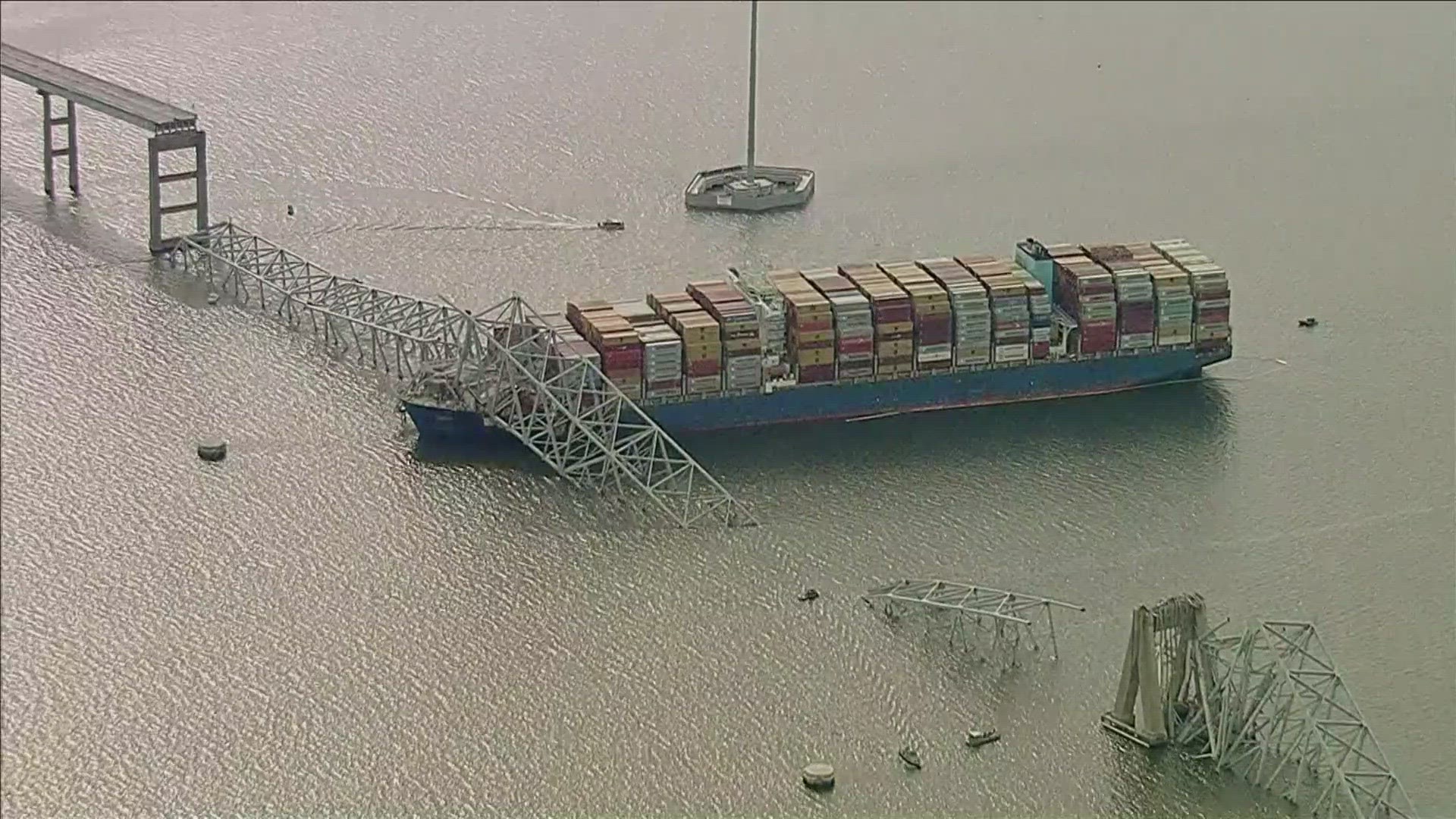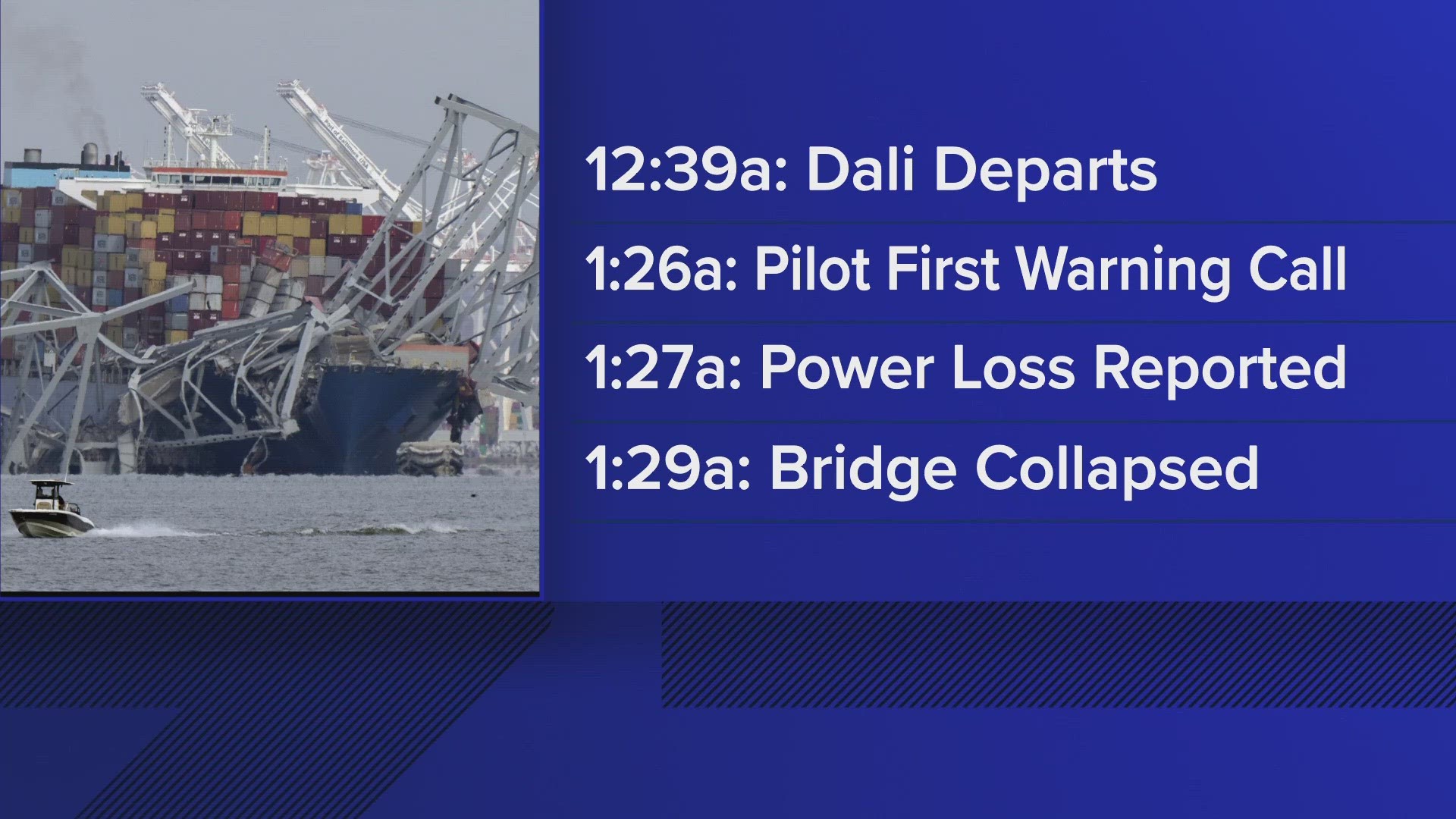Here's everything we know about the Baltimore bridge collapse
Six people are presumed dead. The Francis Scott Key Bridge in Baltimore was described as "one of the cathedrals of American infrastructure."

Family members and officials in Maryland are picking up the pieces Wednesday one day after a cargo ship crashed into the Baltimore Key Bridge – collapsing a large section and plunging eight workers into the cold water – six of whom are presumed dead.
Both the wreckage and the investigation are sprawling, and there are a lot of moving parts, which makes understanding what happened Tuesday in Baltimore a lot to wrap your head around.
Here's everything we know about the collapse of the Francis Scott Key Bridge in Baltimore, not to be confused with the Francis Scott Key Memorial Bridge connecting Arlington to D.C.
The Timeline "An unthinkable tragedy."
At 1:07 a.m. the cargo ship, which is called Dali, entered the Fort McHenry Channel. At 1:24 a.m., numerous alarms were recorded on the ship's bridge audio. At 1:26 a.m., the ship's pilot made a radio call for tug boats in the vicinity of Dali to assist.
At 1:27 a.m., the pilot issued a radio call and reported that Dali had lost all power approaching the Key Bridge.
At that time, a 911 call alerted authorities that a ship had lost power in the Patapsco River, prompting crews on the ground to quickly shut down traffic and stop additional cars from going out on the bridge. Within one minute, the bridge collapsed.
Around 1:40 a.m. Tuesday, 911 dispatchers contacted the Baltimore City Fire Department about a water rescue situation in the Patapsco River in the area of the Francis Scott Key Bridge.
First responders were alerted that numerous people had gone into the water, and as they were working to get to the scene to help, they were informed that a cargo ship may have crashed into the bridge – and that sections of the bridge had come down.
Around 1:50 a.m., the first fire department unit arrived at the scene and reported a complete collapse of the Key Bridge. They were informed that multiple people were on the bridge when it collapsed, and a search and rescue operation was needed.
Divers were in the water by 2:25 a.m.
Baltimore City Fire Chief James Wallace said at a pre-dawn news conference Tuesday that one person was rescued from the water, but they declined to be taken to a hospital and was miraculously uninjured. Wallace said a second person was rescued and taken to the Shock Trauma Center at the University of Maryland Medical Center. He said that person was in "very serious condition."
Wallace said at the news conference, which started around 6:25 a.m., that first responders from multiple jurisdictions around the region responded to the bridge collapse to aid in the search and rescue operation for the people in the water.
>Watch the full early morning news conference below:
Baltimore Mayor Brandon Scott at the news conference called the event an "unthinkable tragedy." Six people were missing in the water while first responders tried to find them all day.
By 7:30 p.m., the U.S. Coast Guard said they were suspending search and rescue efforts – presuming all six people dead in the cold water – and that the operation was now one of recovery.
Around 10 a.m. on Wednesday, divers pulled two victims from a pickup truck that was 25 feet under water.
>Watch the full news conference from Wednesday evening below:
The Victims 2 bodies found, 4 others presumed dead
Eight people went into the water when the bridge collapsed on Tuesday. Only two people made it out alive.
Two bodies were recovered from the Patapsco River near the collapse site Wednesday. They were identified as Alejandro Hernandez Fuentes, 35, who lives in Baltimore – and is originally from Mexico; and Dorlian Ronial Castillo Cabrera, 26, who lives in Dundalk – and is originally from Guatemala.
The four remaining crew members are presumed dead.
"My heart goes out to the families," Maryland Gov. Wes Moore said Tuesday. "This is a – I can't imagine how painful tonight has been. They were fathers, brothers, cousins – they were sons."
A GoFundMe has been created to help raise money for the victim's families. As of Wednesday evening, more than $98,000 had been raised.
Maryland officials have not yet released the names of any other victims. However, CASA, a Latino and immigration advocacy and assistance-based organization in Maryland, confirmed Wednesday that both 34-year-old Maynor Suazo Sandoval, of Honduras, and 40-year-old Miguel Luna, of El Salvador, were working on the bridge at the time of its collapse.
Luna was a husband and a father of three originally from El Salvador. He had been living in Maryland for 19 years. Sandoval was a married father of two from Honduras, who had been in the U.S. for 18 years.
"We know they were hard workers," CASA Executive Director Gustavo Torres said of Luna and and Sadoval. "They loved soccer, their families and their communities. They were extraordinary human beings. They both came at 17 and 19 from central America, to have the American dream, to make a contribution to the nation, to make sure their families have a chance here."
The Consul General of Mexico in Washington, D.C. Rafael Laveaga, noted that the men killed were all construction workers repairing potholes on the bridge at the time of collapse.
"And they are going to be the ones that build the bridge again, the Latino workforce," Laveaga said.
After additional searching, officials have determined there are additional vehicles in the water, but they are trapped under the superstructure of the fallen bridge and cannot be reached.
To that end, the recovery operation is ending and a salvage operation is beginning.
The Francis Scott Key Bridge "This is no ordinary bridge."
The bridge opened in March 1977 and is named for the author of the Star Spangled Banner, Francis Scott Key. It is the outermost of three toll crossings of Baltimore's Harbor. When the bridge was completed, it became the final links in Interstate 695 (the Baltimore Beltway.) The 1.6-mile bridge crosses over the Patapsco River.
The bridge cost an estimated $110 million and was the best alternative for a tunnel at the time because it allowed for more traffic lanes and carried lower operating and maintenance costs. The bridge also allowed for a route across the Baltimore Harbor for vehicles transporting hazardous material, as these materials are prohibited from the Baltimore Harbor and Fort McHenry tunnels.
Construction began for the bridge in 1972 and was opened to the public on March 23, 1977 – marking 47 years it has been in service this year.
The bridge came down early Tuesday morning when a cargo ship apparently lost power and control and collided with one of the bridge's support structures.
"This is no ordinary bridge," U.S. Department of Transportation Pete Buttigieg said Tuesday. "This is one of the cathedrals of American infrastructure. It has been part of the skyline of this region longer than many of us have been alive."
Cars were crossing the bridge seconds before it collapsed, but miraculously, no drivers were on the bridge when it came down.
Gov. Moore said the quick actions to shut down traffic on the bridge an act of heroism that saved lives.
RELATED: 'Heroes' scrambled to stop traffic before Baltimore bridge collapsed; construction crew feared dead
>Here's the moment the Francis Scott Key Bridge came down. Some viewers may find it disturbing:
The Port of Baltimore The economic impact will be "very grave."
One of the busiest cargo ports on the East Coast, and the busiest for car shipments in the country, is at a standstill after the collapse of the Francis Scott Key Bridge.
Vessel traffic in and out of the Port of Baltimore is suspended until further notice and the collapse will undoubtedly have massive implications on Baltimore and Maryland's economy.
“The economic impact to the State of Maryland and Washington D.C. Metropolitan area is going to be very, very grave,” said Scott Cowan, the President of Local 333, International Longshoremen’s Association.
Cowan said most of the cargo that comes through The Port of Baltimore directly serves our region. He’s concerned about the 2,400 workers he represents who now must wait and see. The port generates more than 15,000 jobs and nearly $400 million in state and local tax revenue each year, according to the Maryland Port Administration.
President Joe Biden acknowledged that the port is vital to the economy.
On Wednesday, Buttigieg noted that while it took five years to build the bridge in 1972, that doesn't mean it will take that long to rebuild in 2024. Though, he did not offer a clear timeline for removing the debris and rebuilding the bridge.
>Bridge collapse in Baltimore threatens region with economic challenges:
The Ship 'Dali'
Before the crash, the Dali was bound for Sri Lanka. Now, it's staying put at the crash site.
Federal authorities say 21 crew members and two pilots are on board the container ship that currently has power but cannot move.
The NTSB says the ship's voyage data recorder (VDR) was able to record sound that they believe to be of the moment the ship crashed into the bridge but further investigation is needed to determine the exact moment the collision occurred.
NTSB says the Dali was carrying 56 containers of hazardous materials and that some of those containers have been breached which has made the area dangerous for investigators. Officials were unable to tell us what those materials are and how many of those are actually in the water, but they said some are flammable and both state and federal authorities have been notified.
NTSB Chair Jennifer Homendy says she is aware of the reports about potential electrical outages, but could not confirm if the Dali had experienced issues before the crash.
"We don't have any information of outages on board the vessel prior to that time. Certainly, we are going to look at what we can get from the VDR data," she said. She added that the VDR should have data collected from the last 30 days.
Brittney Melton, Matt Pusatory, Rafael Sanchez-Cruz, Jess Arnold, Robert Viamontes, Matthew Torres, John Doran, and The Associated Press contributed to the reporting of this story.


